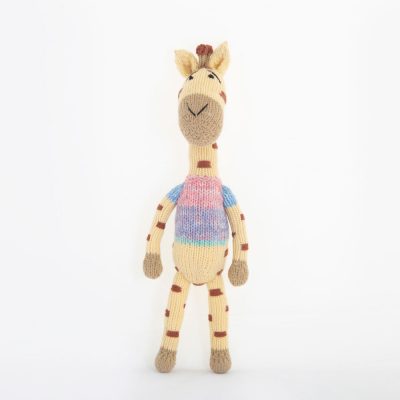
Original: Giraffe (Twiza)
DESCRIPTION
- Giraffes have the same number of bones in their necks as a human
- A group of Giraffes is called a Tower
- Giraffes can grow up to 16 ft (they average 6 ft tall at birth!)
- Giraffes can run up to 56 kmph
- Giraffes give birth standing up – their young have to fall over 5 ft!
- A Giraffe’s tongue can be as long as 53 cm
- Like human fingerprints, no 2 giraffes have the same pattern of spots
PRODUCT DETAILS
- Individually named by the lady who knitted it
- Tagged with the name and photo (unless they are still in prison) of the knitter
- CE tested
- Hand knitted with a mix of acrylic and cotton yarns
- Stuffed with a polyester toy stuffing
- Wash by gentle sponge cleaning
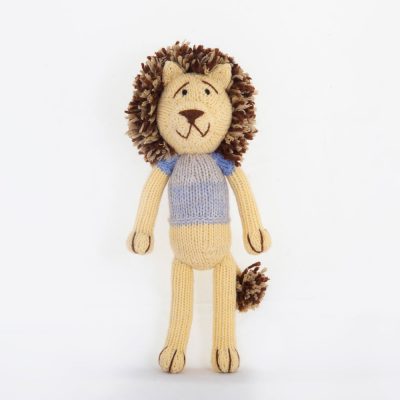
Original: Lion (Shumba)
DESCRIPTION
- A male lion sleeps in his den and the females go out to hunt for food!
- A group of Lions is called a Pride, they are the only cats that live in groups
- A Lion would be defeated by a polar bear if they had a fight!
- A Lions roar can be heard from 8 km away
- Lions can run up to a speed of 81 kmph
- The name for a baby lion is a cub, whelp or lionet
PRODUCT DETAILS
- Individually named by the lady who knitted it
- Tagged with the name and photo (unless they are still in prison) of the knitter
- CE tested
- Hand knitted with a mix of acrylic and cotton yarns
- Stuffed with a polyester toy stuffing
- Wash by gentle sponge cleaning
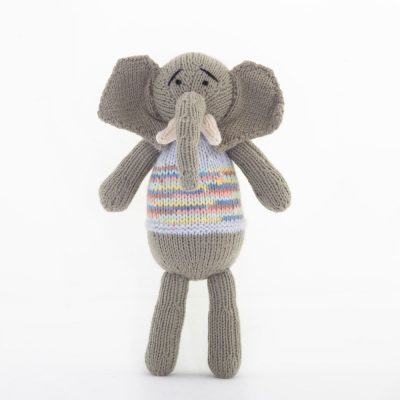
Original: Elephant (Nzou)
DESCRIPTION
- Elephants are the only mammals that can’t jump
- Elephant tusks keep growing all their lives
- An Elephant spends up to 23 hours a day eating!
- Elephants can smell water from 3 miles away
- An Elephant’s skin is up to 2.5 cm thick in places
- A group of Elephants is called a parade
- A male Elephant can weigh up to 6 tons
PRODUCT DETAILS
- Individually named by the lady who knitted it
- Tagged with the name and photo (unless they are still in prison) of the knitter
- CE tested
- Hand knitted with a mix of acrylic and cotton yarns
- Stuffed with a polyester toy stuffing
- Wash by gentle sponge cleaning
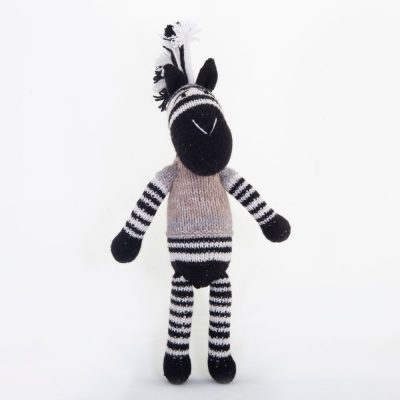
Original: Zebra (Mbizi)
DESCRIPTION
- Zebras are white with black stripes, not black with white stripes!
- Zebras can’t see the colour orange
- A group of Zebras is called a crossing, a dazzle, a herd, a harem or a zeal!
- The stripes of a Zebra are as individual as a fingerprint
- The fastest recorded speed for a Zebra is 112 kmph!
PRODUCT DETAILS
- Individually named by the lady who knitted it
- Tagged with the name and photo (unless they are still in prison) of the knitter
- CE tested
- Hand knitted with a mix of acrylic and cotton yarns
- Stuffed with a polyester toy stuffing
- Wash by gentle sponge cleaning

Original: Fox
DESCRIPTION
- Foxes are members of the dog family
- A group of Foxes is called a skulk or a leash
- A female Fox is called a vixen and a male Fox is called a dog fox or a tod
- A Fox’s home is called a den
- Foxes can run at up to 70 kmph!
PRODUCT DETAILS
- Individually named by the lady who knitted it
- Tagged with the name and photo (unless they are still in prison) of the knitter
- CE tested
- Hand knitted with a mix of acrylic and cotton yarns
- Stuffed with a polyester toy stuffing
- Wash by gentle sponge cleaning
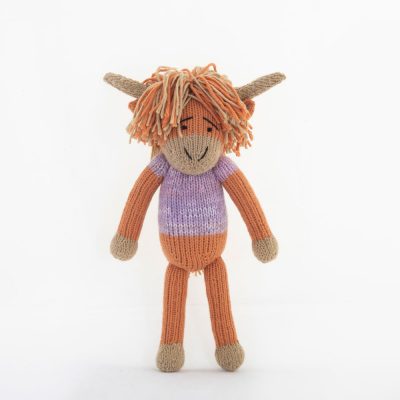
Original: Highland Coo
DESCRIPTION
- Highland Coos originate from the Highlands of Scotland
- The Highland Coo is the oldest registered breed of cow in the world
- A group of Highland cattle is called a fold
- Their long fringe is called a ‘dossan’
- Their long horns are used for foraging and digging through the snow for food in the winter
PRODUCT DETAILS
- Individually named by the lady who knitted it
- Tagged with the name and photo (unless they are still in prison) of the knitter
- CE tested
- Hand knitted with a mix of acrylic and cotton yarns
- Stuffed with a polyester toy stuffing
- Wash by gentle sponge cleaning
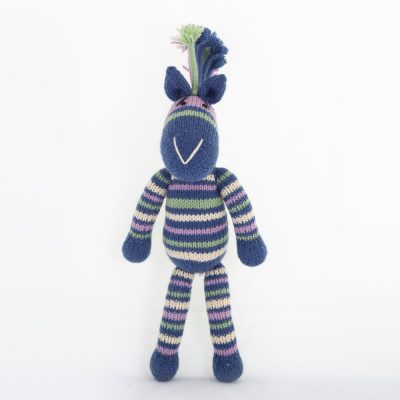
Original: Ruvara Zebra (Mbizi)
DESCRIPTION
- Zebras are white with black stripes, not black with white stripes!
- Zebras can’t see the colour orange
- A group of Zebras is called a crossing, a dazzle, a herd, a harem or a zeal!
- The stripes of a Zebra are as individual as a fingerprint
- The fastest recorded speed for a Zebra is 112 kmph!
- Ruvara means colour in Shona – the main language spoken in Zimbabwe
PRODUCT DETAILS
- Individually named by the lady who knitted it
- Tagged with the name and photo (unless they are still in prison) of the knitter
- CE tested
- Hand knitted with a mix of acrylic and cotton yarns
- Stuffed with a polyester toy stuffing
- Wash by gentle sponge cleaning

Original: Pangolin (Haka)
DESCRIPTION
- Pangolins are the world’s most trafficked mammal – they are targeted for their meat and scales which is used in traditional medicine.
- When it is threatened, a pangolin will curl itself into a tight ball that is impenetrable to predators.
- Baby pangolins travel around with their mother by riding on the base of her tail.
- Pangolins don’t have teeth, instead they have long sticky tongues that they use to eat ants and termites out of their mounds.
- A pangolins tongue can be up to 40 cm long when fully extended – this is the longest tongue to body ration of all mammals.
- Pangolins are the only mammals that are covered in scales
- Pangolin scales are made of keratin, like our fingernails, and make up 20% to 30% of their body weight.
PRODUCT DETAILS
- Individually named by the lady who knitted it
- Tagged with the name and photo (unless they are still in prison) of the knitter
- CE tested
- Hand knitted with a mix of acrylic and cotton yarns
- Stuffed with a polyester toy stuffing
- Wash by gentle sponge cleaning
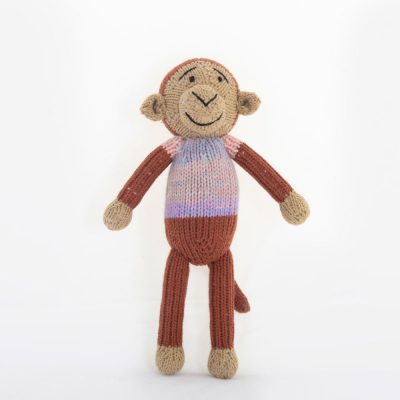
Original: Monkey (Shoko)
DESCRIPTION
- Monkeys peel their bananas and don’t eat the skin
- Albert II was the first monkey in space, he landed on the moon on 14th June 1949
- A group of Monkeys is called a troop, a barrel or a cartload!
- Monkeys can grasp with both their fingers and their toes
- Some monkeys can count and understand written numbers
- To attract a female partner, some species of monkey urinate on their hands and rub it into their fur
PRODUCT DETAILS
- Individually named by the lady who knitted it
- Tagged with the name and photo (unless they are still in prison) of the knitter
- CE tested
- Hand knitted with a mix of acrylic and cotton yarns
- Stuffed with a polyester toy stuffing
- Wash by gentle sponge cleaning
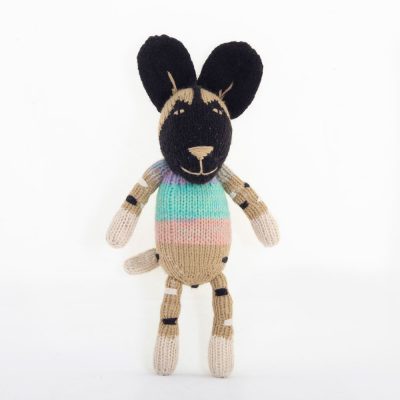
Original: Wild Dog (Mhuhmi)
DESCRIPTION
- The scientific name for the African Wild Dog means ‘Painted Wolf’.
- Wild Dogs have 4 toes on each foot while domestic dogs have 5.
- Wild Dogs can run long distances at speeds of up to 56 kmph.
- No two Wild Dogs have the same markings.
- Wild Dogs can live up to 11 years old in the wild.
- Wild Dogs live and hunt in packs of between 6 and 20 members.
PRODUCT DETAILS
- Individually named by the lady who knitted it
- Tagged with the name and photo (unless they are still in prison) of the knitter
- CE tested
- Hand knitted with a mix of acrylic and cotton yarns
- Stuffed with a polyester toy stuffing
- Wash by gentle sponge cleaning
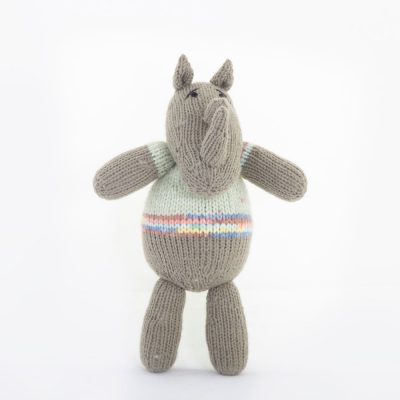
Original: Rhino (Chipembere)
DESCRIPTION
- The name Rhinoceros means ‘nose horn’
- A group of Rhino is called a crash.
- A White Rhino can weigh up to 3500kg
- Relative to their size, Rhinos have small brains
- Rhino horns are made from keratin, the same substance that fingernails and hair are made from
- A Rhino dung pile can be up to 3 feet high
PRODUCT DETAILS
- Individually named by the lady who knitted it
- Tagged with the name and photo (unless they are still in prison) of the knitter
- CE tested
- Hand knitted with a mix of acrylic and cotton yarns
- Stuffed with a polyester toy stuffing
- Wash by gentle sponge cleaning

Original: Sheep (Hwai)
DESCRIPTION
- There are over 1 billion sheep in the world
- Sheep have best friends
- A group of sheep is called a herd, flock or mob
- Sheep have a field of vision of 300 degrees, allowing them to see behind themselves without turning their head
- Sheep have an excellent memory
PRODUCT DETAILS
- Individually named by the lady who knitted it
- Tagged with the name and photo (unless they are still in prison) of the knitter
- CE tested
- Hand knitted with a mix of acrylic and cotton yarns
- Stuffed with a polyester toy stuffing
- Wash by gentle sponge cleaning

